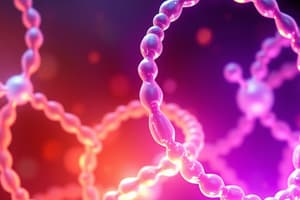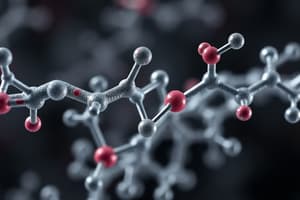Podcast
Questions and Answers
What are macromolecules?
What are macromolecules?
A giant molecule formed by the joining of smaller molecules, usually by a dehydration reaction. Polysaccharides, proteins, and nucleic acids are macromolecules.
What is a polymer?
What is a polymer?
A long molecule consisting of many similar or identical monomers linked together by covalent bonds.
What is a monomer?
What is a monomer?
The subunit that serves as the building block of a polymer.
What is an enzyme?
What is an enzyme?
What is a dehydration reaction?
What is a dehydration reaction?
What is hydrolysis?
What is hydrolysis?
What is a carbohydrate?
What is a carbohydrate?
What is a monosaccharide?
What is a monosaccharide?
What is a disaccharide?
What is a disaccharide?
What is a glycosidic linkage?
What is a glycosidic linkage?
What is a polysaccharide?
What is a polysaccharide?
What is starch?
What is starch?
What is glycogen?
What is glycogen?
What is cellulose?
What is cellulose?
What is chitin?
What is chitin?
What is a lipid?
What is a lipid?
What is fat?
What is fat?
What is a fatty acid?
What is a fatty acid?
What is triacylglycerol?
What is triacylglycerol?
What is a saturated fatty acid?
What is a saturated fatty acid?
What is an unsaturated fatty acid?
What is an unsaturated fatty acid?
What is a trans fat?
What is a trans fat?
What is a phospholipid?
What is a phospholipid?
What is a steroid?
What is a steroid?
What is cholesterol?
What is cholesterol?
What is a catalyst?
What is a catalyst?
What is a polypeptide?
What is a polypeptide?
What is a protein?
What is a protein?
What is an amino acid?
What is an amino acid?
What is a peptide bond?
What is a peptide bond?
What is primary structure in proteins?
What is primary structure in proteins?
What is secondary structure in proteins?
What is secondary structure in proteins?
What is an α helix?
What is an α helix?
What is a β pleated sheet?
What is a β pleated sheet?
What is tertiary structure in proteins?
What is tertiary structure in proteins?
What is a hydrophobic interaction?
What is a hydrophobic interaction?
What is a disulfide bridge?
What is a disulfide bridge?
What is quaternary structure in proteins?
What is quaternary structure in proteins?
What is sickle-cell disease?
What is sickle-cell disease?
What is denaturation in proteins?
What is denaturation in proteins?
What is a chaperonin?
What is a chaperonin?
What is X-ray crystallography?
What is X-ray crystallography?
What is a gene?
What is a gene?
What are nucleic acids?
What are nucleic acids?
What is deoxyribonucleic acid (DNA)?
What is deoxyribonucleic acid (DNA)?
What is ribonucleic acid (RNA)?
What is ribonucleic acid (RNA)?
What are polynucleotides?
What are polynucleotides?
What is a nucleotide?
What is a nucleotide?
What is a pyrimidine?
What is a pyrimidine?
What is a purine?
What is a purine?
What is deoxyribose?
What is deoxyribose?
What is ribose?
What is ribose?
What is a double helix?
What is a double helix?
What does antiparallel refer to in DNA?
What does antiparallel refer to in DNA?
What are the four main classes of large biological molecules?
What are the four main classes of large biological molecules?
How many molecules of water are needed to completely hydrolyze a polymer that is ten monomers long?
How many molecules of water are needed to completely hydrolyze a polymer that is ten monomers long?
Write the formula for a monosaccharide that has three carbons.
Write the formula for a monosaccharide that has three carbons.
What is the formula for maltose formed by two glucose molecules (C6H12O6)?
What is the formula for maltose formed by two glucose molecules (C6H12O6)?
Compare the structure of a fat (triglyceride) with that of a phospholipid.
Compare the structure of a fat (triglyceride) with that of a phospholipid.
Why are human sex hormones considered lipids?
Why are human sex hormones considered lipids?
Why does a denatured protein no longer function normally?
Why does a denatured protein no longer function normally?
What parts of a polypeptide participate in the bonds that hold together secondary structure?
What parts of a polypeptide participate in the bonds that hold together secondary structure?
What is the fundamental basis for the differences between carbohydrates, proteins, and nucleic acids?
What is the fundamental basis for the differences between carbohydrates, proteins, and nucleic acids?
Compare the composition, structure, and function of starch and cellulose.
Compare the composition, structure, and function of starch and cellulose.
Why are lipids not considered macromolecules for polymers?
Why are lipids not considered macromolecules for polymers?
Explain the basis for the structural and functional diversity of proteins.
Explain the basis for the structural and functional diversity of proteins.
What role does complementary base pairing play in the functions of nucleic acids?
What role does complementary base pairing play in the functions of nucleic acids?
Which of the following categories includes all others in the list?
Which of the following categories includes all others in the list?
The enzyme amylase can break glycosidic linkages between glucose monomers only if the monomers are in the α form. Which of the following could amylase break down?
The enzyme amylase can break glycosidic linkages between glucose monomers only if the monomers are in the α form. Which of the following could amylase break down?
Which of the following statements concerning unsaturated fats is true?
Which of the following statements concerning unsaturated fats is true?
The structural level of a protein least affected by a disruption in hydrogen bonding is the:
The structural level of a protein least affected by a disruption in hydrogen bonding is the:
Enzymes that break down DNA catalyze the hydrolysis of the covalent bonds that join nucleotides together. What would happen to DNA molecules treated with these enzymes?
Enzymes that break down DNA catalyze the hydrolysis of the covalent bonds that join nucleotides together. What would happen to DNA molecules treated with these enzymes?
The molecular formula for glucose is C6H12O6. What would be the molecular formula for a polymer made by linking ten glucose molecules together by dehydration reactions?
The molecular formula for glucose is C6H12O6. What would be the molecular formula for a polymer made by linking ten glucose molecules together by dehydration reactions?
Which of the following pairs of base sequences could form a short stretch of a normal double helix of DNA?
Which of the following pairs of base sequences could form a short stretch of a normal double helix of DNA?
Flashcards are hidden until you start studying
Study Notes
Macromolecules
- Macromolecules are large molecules formed by joining smaller ones through dehydration reactions, encompassing polysaccharides, proteins, and nucleic acids.
Polymer and Monomer
- Polymers are long molecules made of many identical or similar monomers linked by covalent bonds.
- Monomers serve as the building blocks of polymers.
Enzymes and Reactions
- Enzymes are macromolecules that act as catalysts, increasing reaction rates without being consumed themselves, predominantly composed of proteins.
- Dehydration reactions bond two molecules together while removing water, whereas hydrolysis adds water to break these bonds, disassembling polymers into monomers.
Carbohydrates
- Carbohydrates include monosaccharides (simple sugars), disaccharides (two monosaccharides), and polysaccharides (long chains of monosaccharides).
- Glucose (C6H12O6) is the core monosaccharide, while maltose (C12H22O11) results from the dehydration of two glucose molecules.
Types of Polysaccharides
- Starch functions as an energy-storage polysaccharide in plants formed by α glycosidic linkages.
- Glycogen, found in liver and muscle tissues, is the animal equivalent of starch.
- Cellulose is a structural polysaccharide in plant cell walls formed by β glycosidic linkages and is not digestible by humans.
- Chitin is another structural polysaccharide found in fungal cell walls and arthropod exoskeletons.
Lipids
- Lipids, including fats, phospholipids, and steroids, are hydrophobic molecules that do not form polymers.
- Fats (or triglycerides) consist of three fatty acids linked to a glycerol molecule.
- Saturated fatty acids have no double bonds, maximizing hydrogen attachment, while unsaturated fatty acids contain one or more double bonds, reducing hydrogen count.
Steroids and Cholesterol
- Steroids have a carbon skeleton of four fused rings and include cholesterol, vital for cell membranes and hormone precursor synthesis.
Proteins
- Proteins are formed by polypeptides linked by peptide bonds and exhibit diverse structures (primary, secondary, tertiary, and quaternary), influencing their functions.
- Primary structure refers to the amino acid sequence; secondary structures include α helices and β pleated sheets formed by hydrogen bonds within the polypeptide backbone.
- Tertiary structure denotes the overall protein shape, while quaternary structure involves the arrangement of multiple polypeptides.
Nucleic Acids
- Nucleic acids, including DNA and RNA, consist of polymers known as polynucleotides made from nucleotide monomers.
- DNA is typically double-stranded, formed from deoxyribose sugars, while RNA is single-stranded and contains ribose sugars.
- Base pairing in nucleic acids ensures accurate replication and functioning, vital for genetic fidelity and protein synthesis.
Genetic Information and Protein Function
- Sickle-cell disease is a genetic disorder caused by a mutation in the β-globin gene affecting hemoglobin structure.
- Denaturation occurs when proteins lose their shape due to broken bonds, rendering them nonfunctional.
- Chaperonins assist in proper protein folding to achieve their functional conformation.
Importance of Structural Diversity
- Variations in primary structures of proteins lead to diverse forms and functions, essential for biological activities.
- The shape of proteins is critical in determining specific roles, with interactions among amino acid side chains influencing folding and functionality.
Distinctions Between Biological Macromolecules
- The four main classes of biological macromolecules are proteins, carbohydrates, lipids, and nucleic acids, with lipids not being classified as polymers due to their structure.
Studying That Suits You
Use AI to generate personalized quizzes and flashcards to suit your learning preferences.




